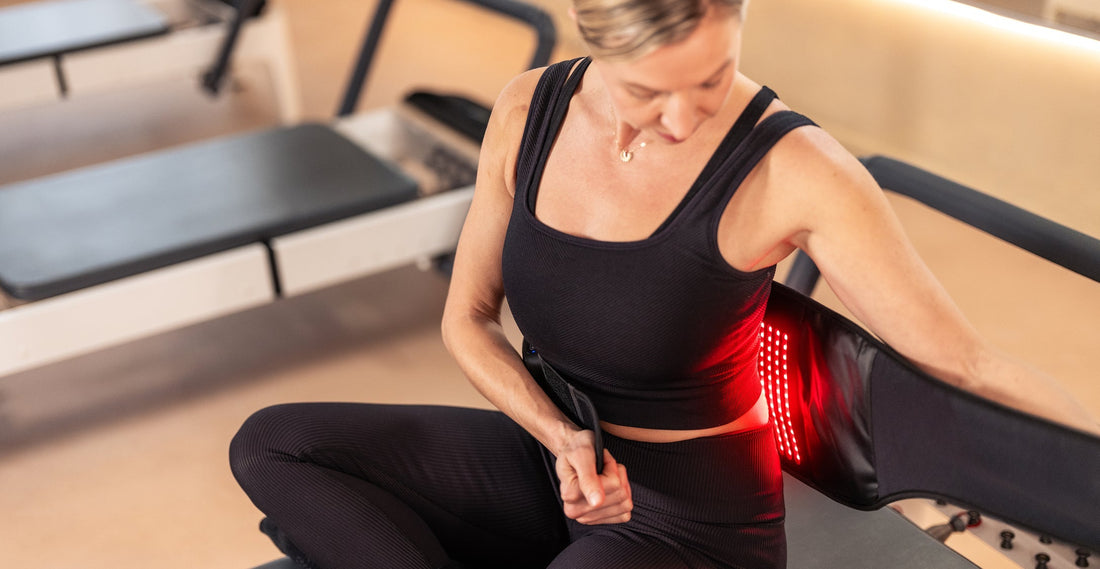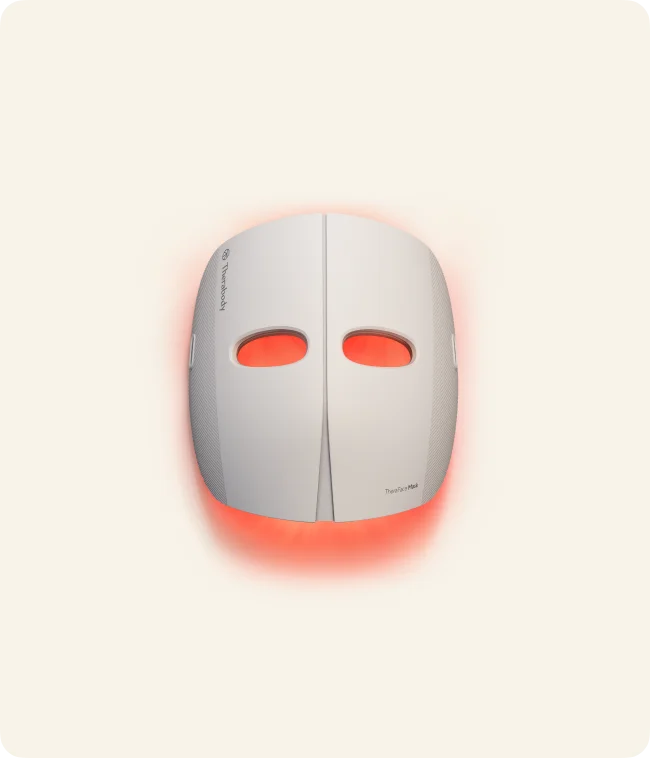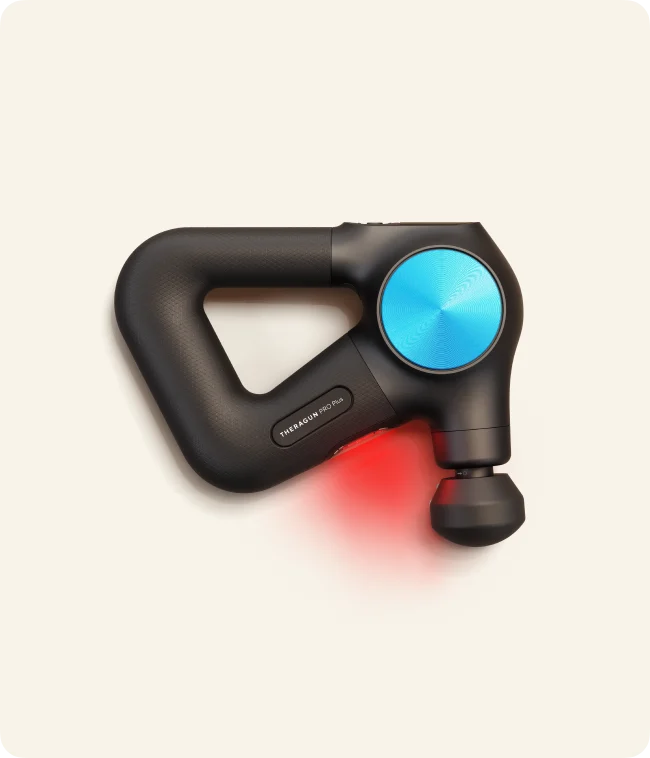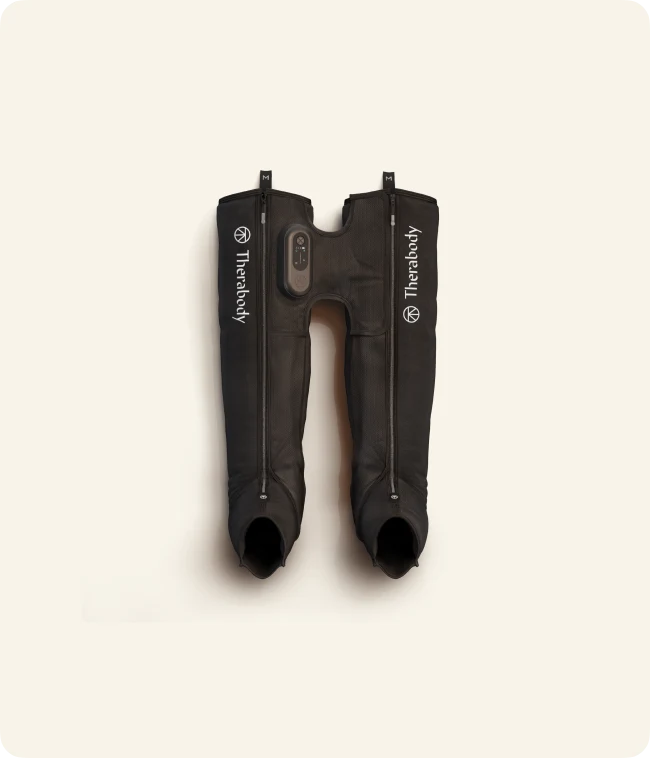
5 Ways Red & Infrared Light Therapy Support Performance & Recovery
Authors: Therabody Scientists: Tim Roberts, MSc; Rachelle Reed, PhD, MS, ACSM-EP; Kyle Silvey, PhD, CSCS; Michelle Darian, MS, MPH, RD, LDN
While you may be familiar with red-light glowing face masks (yes, they really do help rejuvenate the skin), this technology is now also gaining significant momentum among athletes and fitness enthusiasts as a recovery method.
That’s because when certain light wavelengths are applied to skeletal muscles, they can stimulate recovery processes at the cellular level — which traditional recovery methods alone (like stretching and foam rolling) can’t do.
Let’s dive into the science and benefits behind two main types of light therapy — red and infrared light — as well as the technology you can use to enjoy these therapies at home.
What is Light Therapy?
Light therapy refers to the intentional exposure of skin at specific wavelengths. Depending on the wavelength of light, some are visible (like red light therapy), and some are invisible (like infrared therapy).
In addition to being visible or invisible, different light wavelengths penetrate the skin at different depths — shorter wavelengths can impact the surface of the skin, while longer ones can reach deeper (even making their way to the bone). [1]
- The red light spectrum encompasses wavelengths randing from approximately 630 nanometers (nm) to 700 nm.
- Infrared light wavelengths are longer, with near infrared light ranging from 700 nm to 1,400 nm range and far infrared ranging from 3,000 nm to over 100,000 nm.
These wavelengths of light interact with the body's cells and tissues in various ways.
Red light therapy
Red light penetrates the skin tissue to produce therapeutic benefits. [2, 3] It’s particularly known for stimulating the production of adenosine triphosphate (ATP) — the primary energy source of cells.
This allows cells to produce more energy quickly, which can then be used to support cellular repair, regeneration, and improved circulation — all essential for a swift recovery from exercise, (more on this later). [4]
Research also shows that red light therapy can help balance the body’s inflammatory response. In the presence of inflammation, light therapy can stimulate anti-inflammatory processes like releasing antioxidants and inhibiting inflammatory markers. [1]
Lastly, red light therapy has also been shown to promote the release of nitric oxide, which helps expand blood vessels and improves blood flow to the treatment area. [4] These blood flow benefits are also linked to light's therapeutic warming capabilities. While not intense, red light does generate some heat when applied to the skin. [5]
Infrared light therapy
Infrared light is the highest wavelength of light therapy available — reaching far below the skin’s surface and even deeper into the body’s tissues than red light.
This deeper penetration allows infrared light to reach and interact with muscles, joints, and bones. Infrared light therapy can be particularly effective in reducing inflammation, alleviating pain, and promoting tissue repair and regeneration. [6]
Infrared light therapy has a greater warming effect than red light — so you’ll feel this light more prominently during treatment. Like red light, when applied to the skin, infrared light also improves vasodilation and blood flow, which can help reduce stiffness, soreness, and even pain in muscles, joints, and tendons. [5, 7]
5 science-backed benefits of light therapy for performance and recovery
Infrared light has the ability to reach deeper into muscle tissue and bone to stimulate healing, and research on the use of infrared light for performance and recovery is growing. Studies show that infrared light therapy helps to improve:
1. Delayed onset muscle soreness (DOMS)
Delayed Onset Muscle Soreness is the muscle pain and stiffness that occurs 24–72 hours after intense (or new) exercise. Your everyday movements may feel more sluggish or achy — walking up stairs or bending your knees may even feel uncomfortable.
DOMS can also reduce strength, mobility, and your ability to get back to a workout feeling your best quickly. [8]
This soreness is often linked to unresolved muscle damage. And that’s exactly what red and infrared light therapy can help with. Light therapy promotes tissue healing processes by improving blood flow to the muscles — improving oxygen availability and nutrient delivery to the stressed muscle, expediting the muscle's inherent recovery process. [7, 9]
2. Recovery from exercise
Delayed Onset Muscle Soreness is the muscle pain and stiffness that occurs 24–72 hours after intense (or new) exercise. Your everyday movements may feel more sluggish or achy — walking up stairs or bending your knees may even feel uncomfortable.
DOMS can also reduce strength, mobility, and your ability to get back to a workout feeling your best quickly. [8]
This soreness is often linked to unresolved muscle damage. And that’s exactly what red and infrared light therapy can help with. Light therapy promotes tissue healing processes by improving blood flow to the muscles — improving oxygen availability and nutrient delivery to the stressed muscle, expediting the muscle's inherent recovery process. [7, 9]
3. Physical performance
Light therapy can help your muscles work harder, longer, and recover faster by:
- Increasing time until exhaustion: Since light therapy can help cells generate more energy, studies suggest that athletes can sustain higher-intensity efforts for longer before exhaustion hits. [7]
- Increasing repetitions: Performing an exercise to failure is one of the most efficient ways to build muscle. Some studies show that light therapy helps people complete more reps of exercises during resistance training. [7, 12]
- Enhancing muscle strength output: It may also help with stronger force production and better muscle engagement in isometric exercises (exercises that you hold like a plank, wall sit, or bicep-curl hold). [7]
- Blunt lactate accumulation: Improved blood flow helps flush metabolites through the system, delaying fatigue and improving performance. [13]
4. Pain management
It’s estimated that musculoskeletal pain affects 47% of the general population, and medication is the most widely used treatment. [14]
Light therapy — especially infrared light — can reduce feelings of chronic pain thanks to its ability to improve blood flow and lessen inflammation. It may also affect your perception of pain by influencing the brain, spinal cord, and nerve receptors. [15, 16]
This therapy can impact muscle and joint pain, including knee and lower back pain – two common trouble areas.
5. The healing of minor sports-related injuries and wounds
While sports-related injuries and wounds can't always be prevented (like sprains, muscle or tendon strains, tennis elbow, and shin splints), properly recovering from them is essential.
Because light therapy supports ATP energy generation, blood flow, and even lymph flow, it can be an effective, non-invasive treatment to speed up healing from these minor injuries. [17] As always, these therapies should always be coupled with advice from a health professional to ensure proper healing.
Using red light and infrared light therapy devices at home
There are numerous ways to take advantage of light therapy’s benefits on your own at home. Therabody has integrated infrared light therapy into four devices designed to improve performance, enhance recovery, or alleviate pain.
Pro tip: When looking for a device that delivers red light therapy and infrared light therapy, be sure that the device is registered or cleared by the Food and Drug Administration (FDA) for various applications, including temporary relief of muscle and joint pain, increasing blood circulation, and promoting relaxation.
Theragun® PRO Plus
The Theragun PRO Plus is the ultimate multi-therapy device for athletic performance. It combines percussive therapy with vibration, heat, cold, and infrared light. These therapies work even better together than when used individually and help relieve pain, reduce soreness, and improve circulation.
In fact, research from Therabody® Labs put these therapies to the test to see if pairing infrared light with percussive therapy worked better than percussive therapy alone.
After using the Theragun PRO Plus for 60 seconds, infrared LED light therapy improved muscle tone and muscle relaxation 1.5 times faster than percussive therapy alone.
Use it as a warm-up to your workout to prepare the muscles for exercise or reach for it afterward to promote recovery. You can even use it before bed to promote relaxation and restful sleep.
Theragun PRO Plus is a great choice for fitness enthusiasts, athletes, and people who work on their feet all day and want the option to treat muscles in the lower and upper body.
JetBoots® PRO Plus
The JetBoots PRO Plus pairs pneumatic compression, infrared light therapy, and vibration into a compression boot like no other.
Use them before exercise to enhance blood flow and reduce stiffness or post-workout to minimize downtime and prevent soreness.
These boots are ideal for folks who undergo a lot of lower body stress — especially runners and cyclists and those who stand on their feet all day (or night) for their jobs — as they can also help stiff knees and ankles.
RecoveryPulse®
Therabody’s RecoveryPulse sleeves provide graduated compression, vibration, and germanium-infused fabric that provides far-infrared benefits.
Slide them on before or after a workout, at your desk, or before bed for a quick treatment to help reduce pain and soreness, improve blood flow, and enhance relaxation.
Reach for the RecoveryPulse Arm if you play upper body sports and are managing tennis or golfer’s elbow. RecoveryPulse Calf is beneficial for those more engaged in lower-body sports.
If you’re someone who regularly leans on static compression garments (like socks), you can benefit from RecoveryPulse’s innovative therapies.
ThermBack LED
This wearable 4-in-1 therapy delivers heat, vibration, and infrared light directly to the lower back. Together, these therapies provide pain relief, reduce stiffness, promote healing, and improve mobility.
The ThermBack LED is for anyone who experiences acute or chronic low back pain or is treating minor injuries (like muscle tweaks, sprains, and strains). Wear it around the house, at your desk, or while watching television.
Key takeaways
- Both red and infrared light therapy support exercise performance and recovery.
- Infrared light penetrates deep into the body's tissues to stimulate energy production, improve blood flow, and promote tissue repair.
- You can take advantage of these science-backed therapies in your daily routine with the help of the right technology.
- Therabody offers a suite of products that include infrared light for fitness and recovery, including the Theragun PRO Plus, JetBoots PRO Plus, RecoveryPulse, and ThermBack LED.
- If you're looking for light therapy for skin health, check out the TheraFace Mask and the TheraFace PRO.
References:
- https://pubmed.ncbi.nlm.nih.gov/28070154/
- https://pubmed.ncbi.nlm.nih.gov/16414908/
- https://pubmed.ncbi.nlm.nih.gov/36310510/
- https://pubmed.ncbi.nlm.nih.gov/28748217/
- https://pubmed.ncbi.nlm.nih.gov/24197518/
- https://link.springer.com/article/10.1007/s10103-017-2368-6
- https://pubmed.ncbi.nlm.nih.gov/27874264/
- https://pubmed.ncbi.nlm.nih.gov/30537791/
- https://pubmed.ncbi.nlm.nih.gov/25397864/
- https://pubmed.ncbi.nlm.nih.gov/24286286/





